What are the steps of python web crawler
Python web crawler steps: first prepare the required libraries and write the crawler scheduler; then write the url manager and web page downloader; then write the web page parser; and finally write the web page outputter.
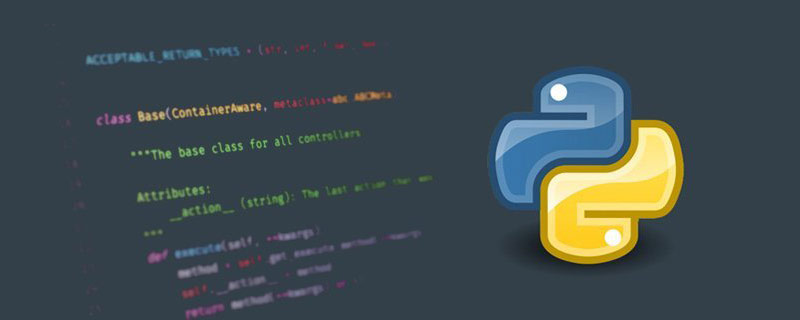
The operating environment of this tutorial: Windows 7 system, python version 3.9, DELL G3 computer.
python web crawler steps
(1) Prepare the required libraries
We need to prepare a software called BeautifulSoup ( Web page parsing) is an open source library that is used to parse downloaded web pages. We use the PyCharm compilation environment, so we can download the open source library directly.
The steps are as follows:
Select File->Settings
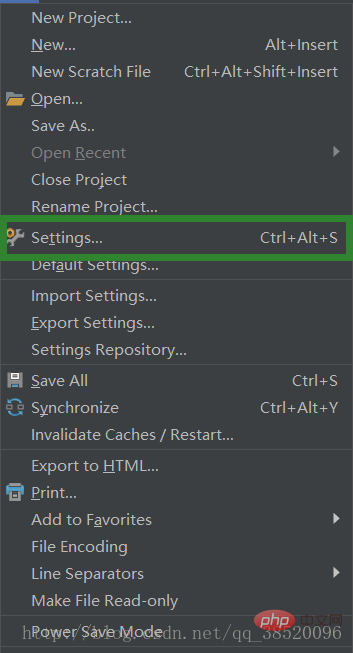
Open the Project interpreter under Project:PythonProject
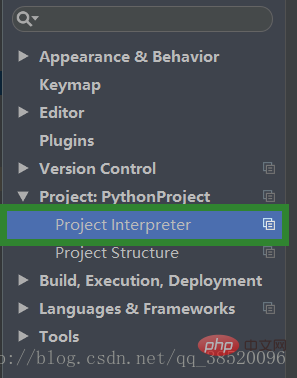
Click the plus sign to add a new library
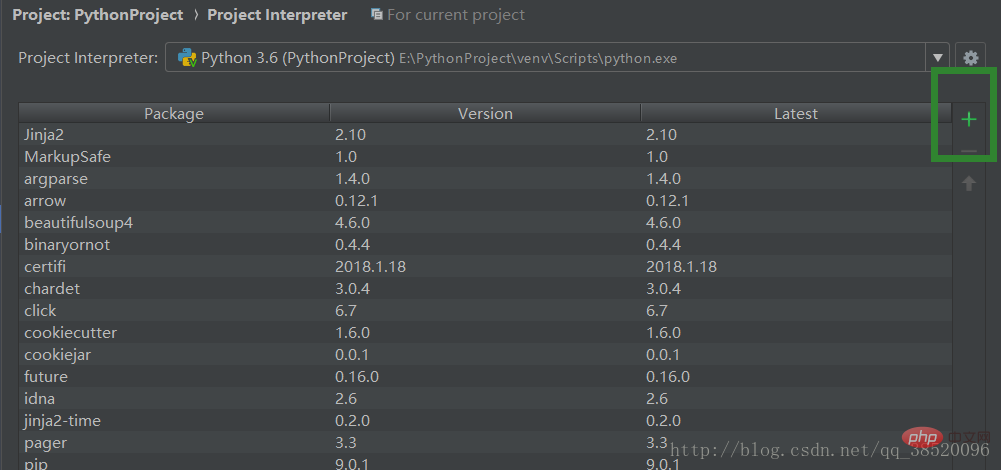
Enter bs4, select bs4 and click Install Packge to download
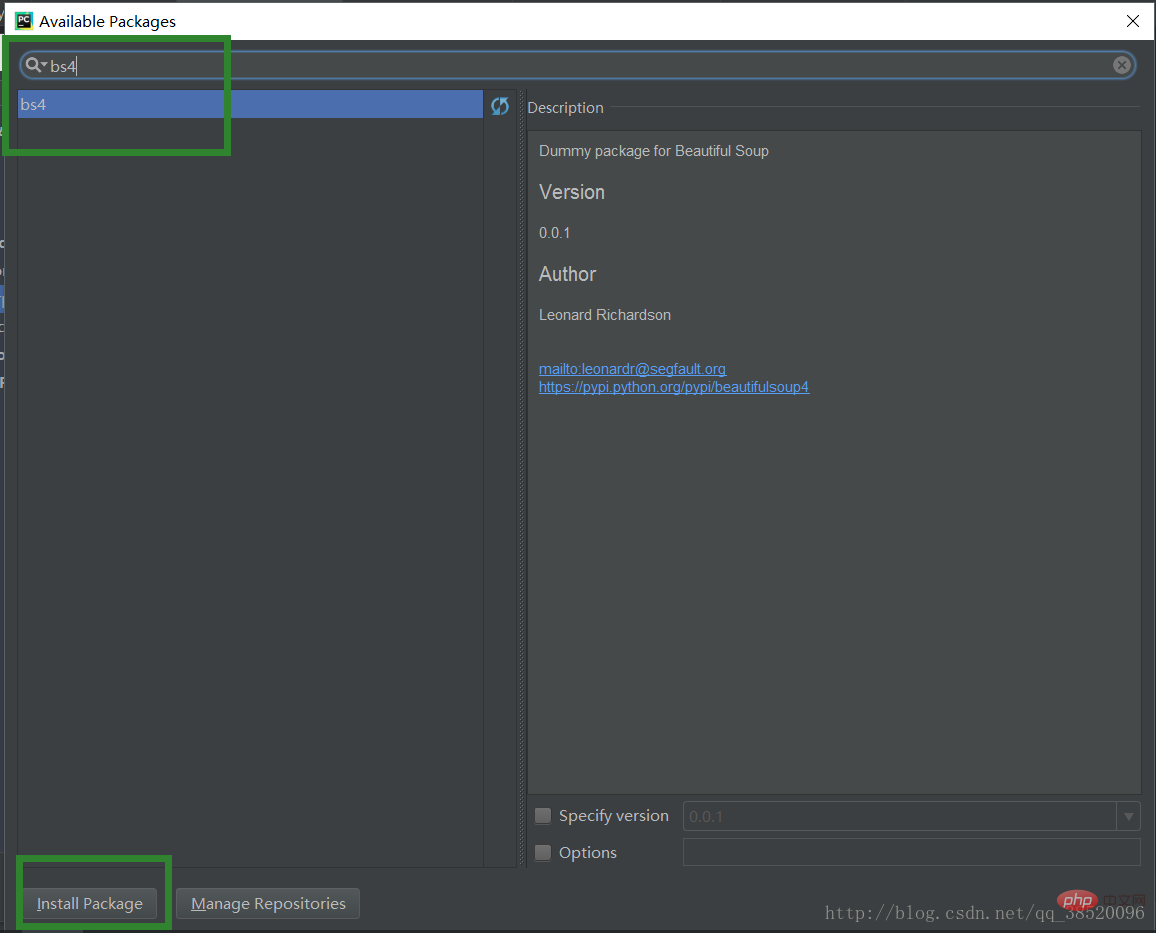
(2) Write a crawler scheduler
The bike_spider here is the four classes introduced by the project name, corresponding to the following four sections of code url manager, url downloader, url parser, url outputter.
# 爬虫调度程序
from bike_spider import url_manager, html_downloader, html_parser, html_outputer
# 爬虫初始化
class SpiderMain(object):
def __init__(self):
self.urls = url_manager.UrlManager()
self.downloader = html_downloader.HtmlDownloader()
self.parser = html_parser.HtmlParser()
self.outputer = html_outputer.HtmlOutputer()
def craw(self, my_root_url):
count = 1
self.urls.add_new_url(my_root_url)
while self.urls.has_new_url():
try:
new_url = self.urls.get_new_url()
print("craw %d : %s" % (count, new_url))
# 下载网页
html_cont = self.downloader.download(new_url)
# 解析网页
new_urls, new_data = self.parser.parse(new_url, html_cont)
self.urls.add_new_urls(new_urls)
# 网页输出器收集数据
self.outputer.collect_data(new_data)
if count == 10:
break
count += 1
except:
print("craw failed")
self.outputer.output_html()
if __name__ == "__main__":
root_url = "http://baike.baidu.com/item/Python/407313"
obj_spider = SpiderMain()
obj_spider.craw(root_url)(3) Write url manager
We store the URLs that have been crawled and the URLs that have not been crawled separately so that we will not repeat them Crawl some already crawled web pages.
# url管理器
class UrlManager(object):
def __init__(self):
self.new_urls = set()
self.old_urls = set()
def add_new_url(self, url):
if url is None:
return
if url not in self.new_urls and url not in self.old_urls:
self.new_urls.add(url)
def add_new_urls(self, urls):
if urls is None or len(urls) == 0:
return
for url in urls:
self.new_urls.add(url)
def get_new_url(self):
# pop方法会帮我们获取一个url并且移除它
new_url = self.new_urls.pop()
self.old_urls.add(new_url)
return new_url
def has_new_url(self):
return len(self.new_urls) != 0(4) Write a web page downloader
Download the page through a network request
# 网页下载器
import urllib.request
class HtmlDownloader(object):
def download(self, url):
if url is None:
return None
response = urllib.request.urlopen(url)
# code不为200则请求失败
if response.getcode() != 200:
return None
return response.read()(5) Write a web page Parser
When parsing a web page, we need to know what characteristics the content we want to query has. We can open a web page, right-click and inspect the elements to understand the commonalities of the content we are querying.
# 网页解析器
import re
from bs4 import BeautifulSoup
from urllib.parse import urljoin
class HtmlParser(object):
def parse(self, page_url, html_cont):
if page_url is None or html_cont is None:
return
soup = BeautifulSoup(html_cont, "html.parser", from_encoding="utf-8")
new_urls = self._get_new_urls(page_url, soup)
new_data = self._get_new_data(page_url, soup)
return new_urls, new_data
def _get_new_data(self, page_url, soup):
res_data = {"url": page_url}
# 获取标题
title_node = soup.find("dd", class_="lemmaWgt-lemmaTitle-title").find("h1")
res_data["title"] = title_node.get_text()
summary_node = soup.find("p", class_="lemma-summary")
res_data["summary"] = summary_node.get_text()
return res_data
def _get_new_urls(self, page_url, soup):
new_urls = set()
# 查找出所有符合下列条件的url
links = soup.find_all("a", href=re.compile(r"/item/"))
for link in links:
new_url = link['href']
# 获取到的url不完整,学要拼接
new_full_url = urljoin(page_url, new_url)
new_urls.add(new_full_url)
return new_urls(6) Write a web page outputter
There are many output formats. We choose to output in the form of html so that we can get a html page.
# 网页输出器
class HtmlOutputer(object):
def __init__(self):
self.datas = []
def collect_data(self, data):
if data is None:
return
self.datas.append(data)
# 我们以html表格形式进行输出
def output_html(self):
fout = open("output.html", "w", encoding='utf-8')
fout.write("<html>")
fout.write("<meta charset='utf-8'>")
fout.write("<body>")
# 以表格输出
fout.write("<table>")
for data in self.datas:
# 一行
fout.write("<tr>")
# 每个单元行的内容
fout.write("<td>%s</td>" % data["url"])
fout.write("<td>%s</td>" % data["title"])
fout.write("<td>%s</td>" % data["summary"])
fout.write("</tr>")
fout.write("</table>")
fout.write("</body>")
fout.write("</html>")
# 输出完毕后一定要关闭输出器
fout.close()Related free learning recommendations: python video tutorial
The above is the detailed content of What are the steps of python web crawler. For more information, please follow other related articles on the PHP Chinese website!

Hot AI Tools

Undresser.AI Undress
AI-powered app for creating realistic nude photos

AI Clothes Remover
Online AI tool for removing clothes from photos.

Undress AI Tool
Undress images for free

Clothoff.io
AI clothes remover

Video Face Swap
Swap faces in any video effortlessly with our completely free AI face swap tool!

Hot Article

Hot Tools

Notepad++7.3.1
Easy-to-use and free code editor

SublimeText3 Chinese version
Chinese version, very easy to use

Zend Studio 13.0.1
Powerful PHP integrated development environment

Dreamweaver CS6
Visual web development tools

SublimeText3 Mac version
God-level code editing software (SublimeText3)

Hot Topics
 PHP and Python: Different Paradigms Explained
Apr 18, 2025 am 12:26 AM
PHP and Python: Different Paradigms Explained
Apr 18, 2025 am 12:26 AM
PHP is mainly procedural programming, but also supports object-oriented programming (OOP); Python supports a variety of paradigms, including OOP, functional and procedural programming. PHP is suitable for web development, and Python is suitable for a variety of applications such as data analysis and machine learning.
 Choosing Between PHP and Python: A Guide
Apr 18, 2025 am 12:24 AM
Choosing Between PHP and Python: A Guide
Apr 18, 2025 am 12:24 AM
PHP is suitable for web development and rapid prototyping, and Python is suitable for data science and machine learning. 1.PHP is used for dynamic web development, with simple syntax and suitable for rapid development. 2. Python has concise syntax, is suitable for multiple fields, and has a strong library ecosystem.
 PHP and Python: A Deep Dive into Their History
Apr 18, 2025 am 12:25 AM
PHP and Python: A Deep Dive into Their History
Apr 18, 2025 am 12:25 AM
PHP originated in 1994 and was developed by RasmusLerdorf. It was originally used to track website visitors and gradually evolved into a server-side scripting language and was widely used in web development. Python was developed by Guidovan Rossum in the late 1980s and was first released in 1991. It emphasizes code readability and simplicity, and is suitable for scientific computing, data analysis and other fields.
 Python vs. JavaScript: The Learning Curve and Ease of Use
Apr 16, 2025 am 12:12 AM
Python vs. JavaScript: The Learning Curve and Ease of Use
Apr 16, 2025 am 12:12 AM
Python is more suitable for beginners, with a smooth learning curve and concise syntax; JavaScript is suitable for front-end development, with a steep learning curve and flexible syntax. 1. Python syntax is intuitive and suitable for data science and back-end development. 2. JavaScript is flexible and widely used in front-end and server-side programming.
 How to run sublime code python
Apr 16, 2025 am 08:48 AM
How to run sublime code python
Apr 16, 2025 am 08:48 AM
To run Python code in Sublime Text, you need to install the Python plug-in first, then create a .py file and write the code, and finally press Ctrl B to run the code, and the output will be displayed in the console.
 Can vs code run in Windows 8
Apr 15, 2025 pm 07:24 PM
Can vs code run in Windows 8
Apr 15, 2025 pm 07:24 PM
VS Code can run on Windows 8, but the experience may not be great. First make sure the system has been updated to the latest patch, then download the VS Code installation package that matches the system architecture and install it as prompted. After installation, be aware that some extensions may be incompatible with Windows 8 and need to look for alternative extensions or use newer Windows systems in a virtual machine. Install the necessary extensions to check whether they work properly. Although VS Code is feasible on Windows 8, it is recommended to upgrade to a newer Windows system for a better development experience and security.
 Where to write code in vscode
Apr 15, 2025 pm 09:54 PM
Where to write code in vscode
Apr 15, 2025 pm 09:54 PM
Writing code in Visual Studio Code (VSCode) is simple and easy to use. Just install VSCode, create a project, select a language, create a file, write code, save and run it. The advantages of VSCode include cross-platform, free and open source, powerful features, rich extensions, and lightweight and fast.
 Can visual studio code be used in python
Apr 15, 2025 pm 08:18 PM
Can visual studio code be used in python
Apr 15, 2025 pm 08:18 PM
VS Code can be used to write Python and provides many features that make it an ideal tool for developing Python applications. It allows users to: install Python extensions to get functions such as code completion, syntax highlighting, and debugging. Use the debugger to track code step by step, find and fix errors. Integrate Git for version control. Use code formatting tools to maintain code consistency. Use the Linting tool to spot potential problems ahead of time.






